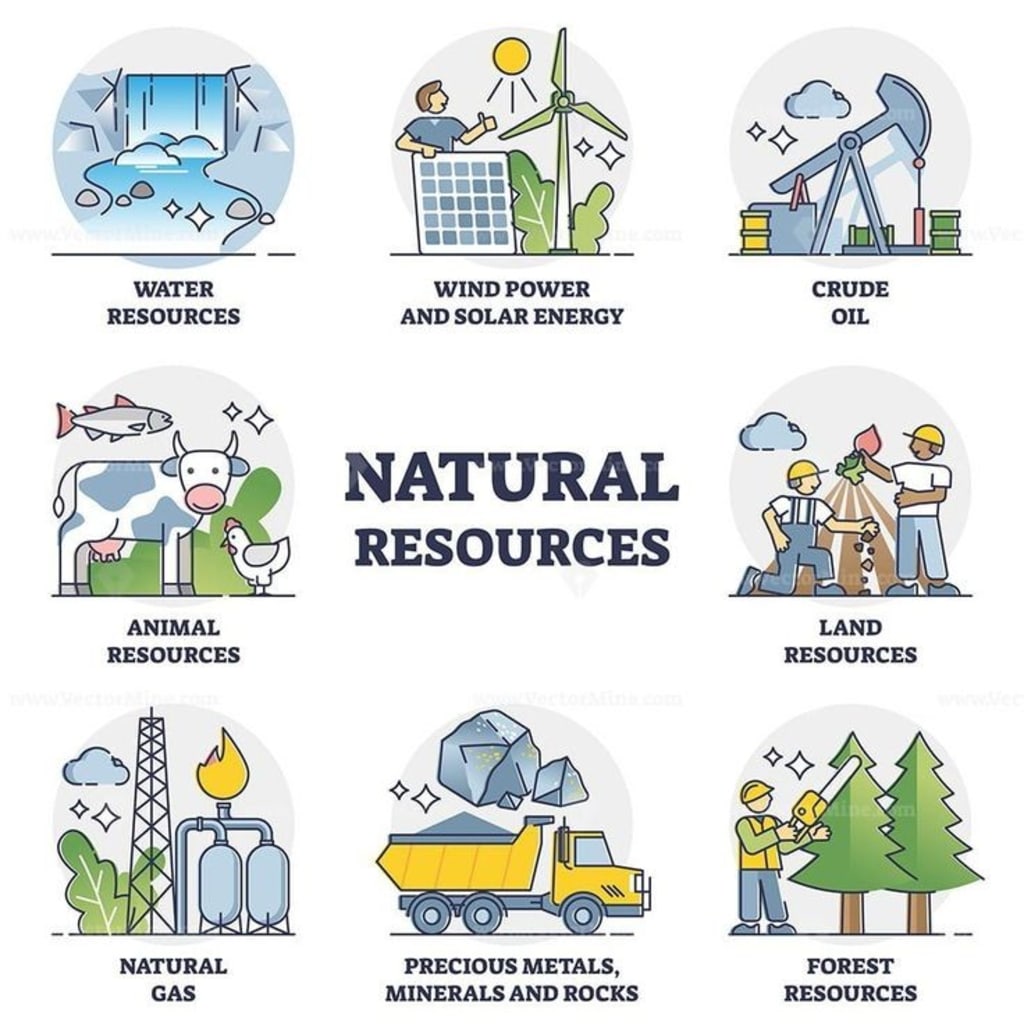
Natural resources are materials and substances that occur in nature and can be utilized for economic gain and human well-being. These resources include water, air, minerals, forests, wildlife, and fossil fuels. They are essential for the survival and development of human societies, providing the raw materials for food, shelter, energy, and industrial products. Understanding the types, uses, management, and challenges associated with natural resources is crucial for sustainable development.
Types of Natural Resources
Natural resources can be broadly categorized into renewable and non-renewable resources.
1. Renewable Resources:
Renewable resources are those that can be replenished naturally over relatively short periods of time. They include:
Water: Essential for all forms of life, water is used for drinking, agriculture, industry, and sanitation. It is replenished through the water cycle, involving evaporation, condensation, precipitation, and runoff.
Forests: Forests provide timber, fuel, food, and medicinal plants. They play a critical role in regulating the climate, maintaining biodiversity, and protecting watersheds.
Solar Energy: Derived from the Sun, solar energy is harnessed using photovoltaic cells and solar thermal systems for electricity generation and heating.
Wind Energy: Wind energy is captured using wind turbines to produce electricity. It is a clean and renewable source of power.
Biomass: Biomass includes plant and animal materials used for energy production, such as wood, crop residues, and manure. It is a renewable energy source when managed sustainably.
Geothermal Energy: This energy is derived from the Earth’s internal heat and can be used for electricity generation and direct heating applications.
2. Non-Renewable Resources:
Non-renewable resources are those that exist in finite quantities and cannot be replenished within a human timescale. They include:
Fossil Fuels: Coal, oil, and natural gas are fossil fuels formed from the remains of ancient plants and animals. They are the primary sources of energy for transportation, electricity generation, and industrial processes.
Minerals: Minerals such as iron, copper, gold, and aluminum are extracted from the Earth for use in construction, manufacturing, and technology. Once depleted, they cannot be replaced.
Nuclear Fuels: Uranium and thorium are used in nuclear reactors to generate electricity. These resources are finite and require careful management due to their radioactive nature.
Uses of Natural Resources
Natural resources are utilized in various ways to support human activities and economic development. Key uses include:
1. Agriculture:
Soil: Soil is a critical resource for agriculture, providing the medium for growing crops. Fertile soil supports food production and sustains livelihoods.
Water: Irrigation is essential for agriculture, especially in arid and semi-arid regions. Water resources are used to cultivate crops and raise livestock.
2. Industry:
Minerals: Minerals are fundamental to industrial activities. Iron and aluminum are used in construction and manufacturing, while rare earth elements are vital for electronics and renewable energy technologies.
Energy: Fossil fuels, nuclear energy, and renewables power industries, driving economic growth and development.
3. Construction:
Timber: Forests provide timber for construction, furniture, and paper products. Sustainable forestry practices ensure a continuous supply of wood.
Sand and Gravel: These materials are used in construction for making concrete, roads, and buildings.
4. Transportation:
Fossil Fuels: Oil is the primary energy source for transportation, fueling cars, trucks, ships, and airplanes. The transition to renewable energy sources is ongoing to reduce dependence on fossil fuels.
5. Energy Production:
Fossil Fuels: Coal, oil, and natural gas are burned to generate electricity. They have been the dominant energy sources for decades but are being gradually replaced by cleaner alternatives.
Renewables: Solar, wind, hydroelectric, and geothermal energy are increasingly used for electricity generation, reducing greenhouse gas emissions and environmental impacts.
6. Technology:
Minerals: Rare earth elements, lithium, and other minerals are essential for the production of electronic devices, batteries, and renewable energy systems. The demand for these resources is growing with technological advancements.
Management of Natural Resources
Effective management of natural resources is crucial for ensuring their sustainability and minimizing environmental impacts. Key management practices include:
1. Conservation:
Protected Areas: Establishing national parks, wildlife reserves, and marine protected areas helps conserve biodiversity and ecosystems.
Sustainable Forestry: Practices such as selective logging, reforestation, and afforestation ensure that forests are managed sustainably.
2. Sustainable Agriculture:
Soil Management: Techniques like crop rotation, cover cropping, and organic farming maintain soil fertility and prevent erosion.
Water Management: Efficient irrigation systems, rainwater harvesting, and watershed management optimize water use in agriculture.
3. Renewable Energy Development:
Investment: Investing in renewable energy infrastructure, research, and development reduces dependence on fossil fuels and promotes clean energy.
Policy: Implementing policies and incentives for renewable energy adoption encourages the transition to sustainable energy sources.
4. Recycling and Reuse:
Materials Recycling: Recycling metals, plastics, and paper reduces the demand for raw materials and minimizes waste.
Circular Economy: Promoting a circular economy where products are designed for reuse, repair, and recycling enhances resource efficiency.
5. Pollution Control:
Regulations: Enforcing environmental regulations and standards limits pollution from industrial activities, agriculture, and transportation.
Technologies: Developing and adopting cleaner technologies and practices reduces emissions and environmental contamination.
Challenges and Solutions
The sustainable management of natural resources faces several challenges, including:
1. Overexploitation:
Problem: Overexploitation of resources such as forests, fisheries, and minerals leads to depletion and environmental degradation.
Solution: Implementing sustainable harvesting practices, quotas, and regulations ensures that resource use does not exceed regenerative capacities.
2. Climate Change:
Problem: Climate change affects water availability, agriculture, and ecosystems, exacerbating resource scarcity.
Solution: Mitigating climate change through reducing greenhouse gas emissions, transitioning to renewable energy, and enhancing carbon sequestration.
3. Pollution:
Problem: Pollution from industrial activities, agriculture, and urbanization contaminates air, water, and soil, harming ecosystems and human health.
Solution: Implementing pollution control measures, adopting cleaner technologies, and promoting sustainable practices.
4. Habitat Destruction:
Problem: Deforestation, urban expansion, and infrastructure development lead to habitat loss and biodiversity decline.
Solution: Protecting natural habitats, restoring degraded ecosystems, and promoting land-use planning that balances development and conservation.
5. Resource Inequity:
Problem: Unequal access to resources leads to social and economic disparities, with marginalized communities often facing resource scarcity and environmental degradation.
Solution: Promoting equitable resource distribution, community-based resource management, and policies that address social and environmental justice.
6. Governance:
Problem: Weak governance and lack of enforcement of environmental laws lead to resource mismanagement and illegal exploitation.
Solution: Strengthening governance frameworks, enhancing transparency and accountability, and involving local communities in resource management.
Conclusion
Natural resources are the foundation of human society, providing essential materials and services for survival and development. Effective management and conservation of these resources are crucial for ensuring their sustainability and minimizing environmental impacts. Addressing challenges such as overexploitation, climate change, pollution, habitat destruction, resource inequity, and governance requires coordinated efforts at local, national, and global levels. By adopting sustainable practices, investing in renewable energy, promoting conservation, and enhancing governance, we can ensure that natural resources continue to support human well-being and ecological balance for future generations.
About the Creator
Enjoyed the story? Support the Creator.
Subscribe for free to receive all their stories in your feed. You could also pledge your support or give them a one-off tip, letting them know you appreciate their work.





Comments
There are no comments for this story
Be the first to respond and start the conversation.